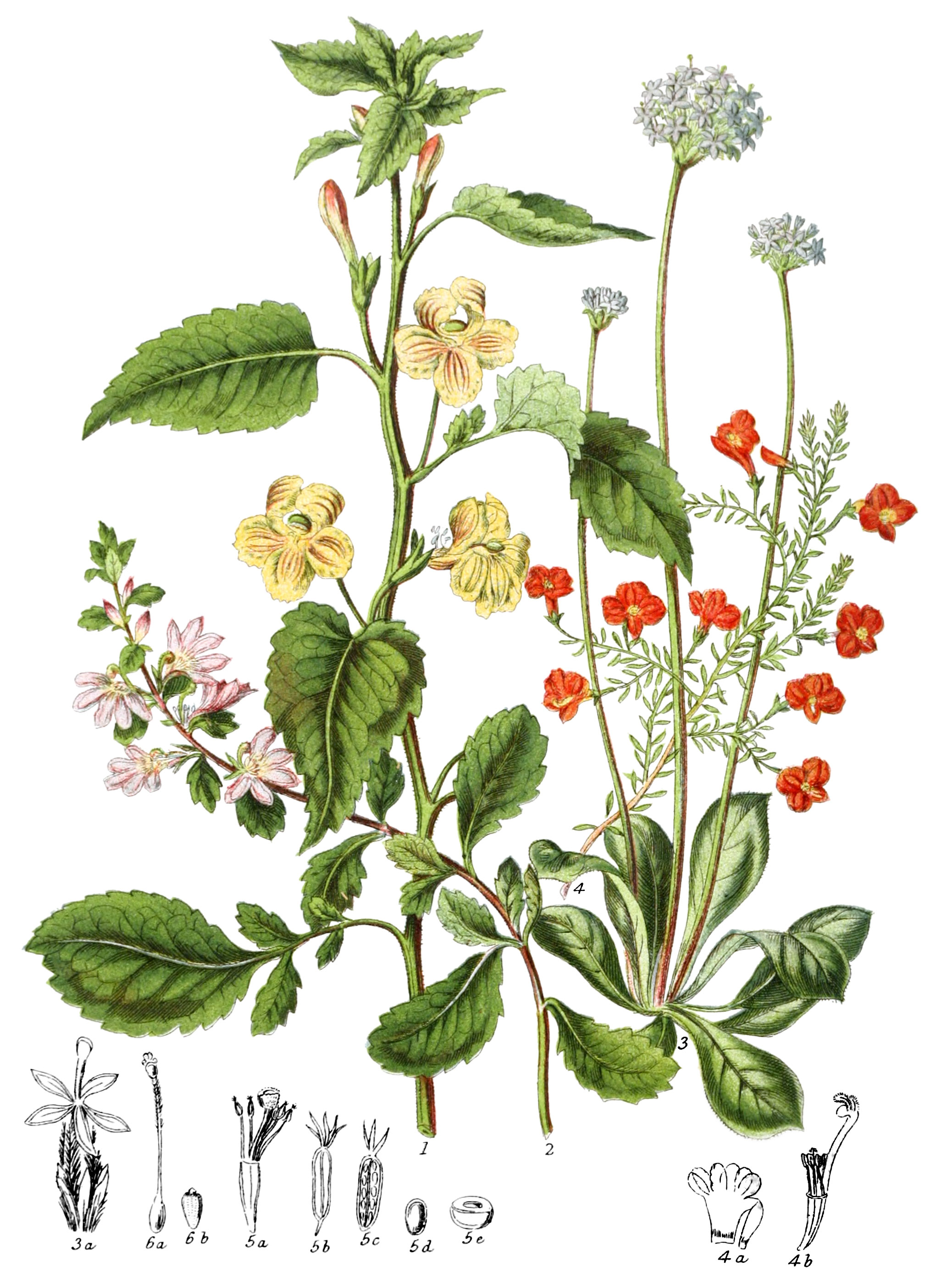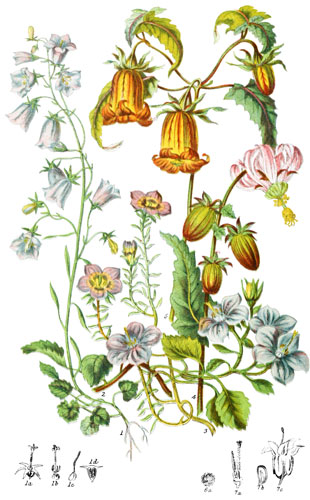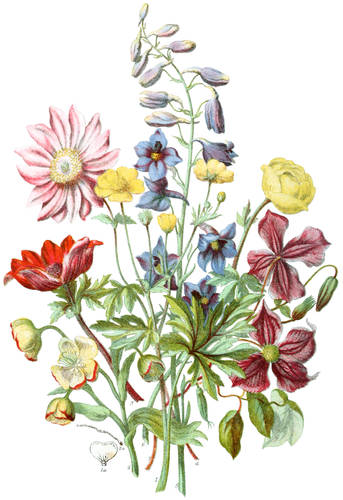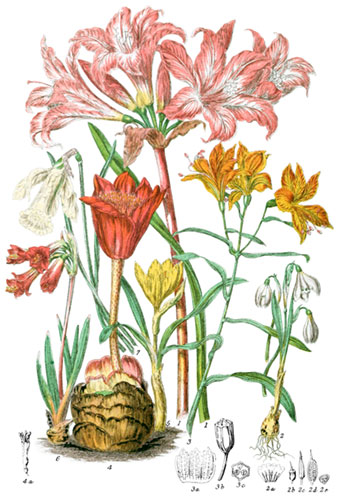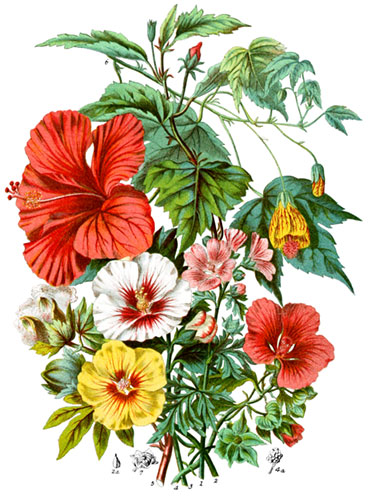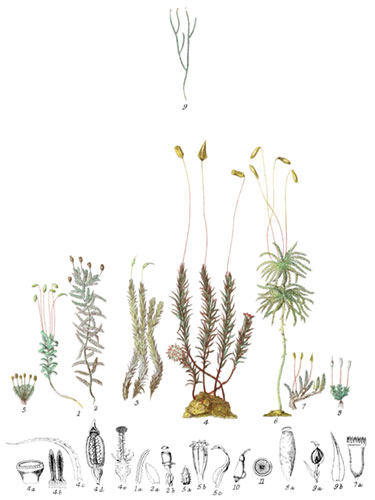Key characteristics
Herbaceous plants, rarely shrubs, without any milky juice, sometimes with simple glandular hairs. The leaves are scattered, rarely opposite, sometimes proceeding from the base of the stem, often lobed, without stipules. The flowers usually at the ends of the branches or stalks; generally distinct, in Brunonia collected in heads, surrounded by enlarged tracts. The calyx is usually above the ovary, rarely below, equal or unequal, three or five-parted, in Brunonia clothed with long hairs. The corolla is of one petal, more or less irregular, the tube sometimes split at the back, five-parted, usually divided into two lips; the edges of the three largest petals sometimes thinner than the centre, and folded inwards in the bud. The stamens are five, distinct, alternate with divisions of the corolla, the filament jointed in Brunonia, as in some of the Compositaceæ; the anthers distinct or cohering, two-celled. The ovary is one or two-celled, rarely four-celled, with few or many ovules; the style is single, very rarely divided, sometimes hairy, the stigma fleshy, undivided or two-lobed, surrounded by or inclosed in a two-valved membranous cup. The seed-vessel is a capsule with solitary or numerous seeds attached to the central partition. The seeds have sometimes a thickened covering; they contain fleshy albumen; the solitary seed of Brunonia has no albumen.
This Order has some connexion with Compositaceæ, but the peculiar stigma distinguishes it from all others.
Select plants in this order
Not all plants listed are illustrated and not all plants illustrated are listed.
- Goodenia which gives the name to this Tribe, was so called by Sir James E. Smith, in honour of his friend Dr. Goodenough, Bishop of Carlisl, a friend and patron of botanists and of natural history.
- G. grandiflora (1) is the finest of the species; the flowers have an agreeable scent; the two upper divisions of the corolla bend over the stigma, forming a kind of hood. Before the flower-bud is unfolded the style is of the same length as the stamens, the stigma is in an erect position, and the anthers shed the pollen into its hollow cup. When the flower is expanded the style lengthens, the stigma becomes two-valved rather than a cup, and the stamens wither and bend outwards.
- G. ovata (5)* is a nearly similar species.
- Scævola is the most extended genus of this tribe; S. microcarpa (2) the species best known in this country, was obtained from some specimens of the earths of Botany Bay in 1793, and may be now occasionally seen in our conservatories.
- S. Lobelia with white flowers is a native of the West Indies.
- S. Kænigii and S. Taccada grow on the coast of the Bay of Bengal, and also along the shores of southern India; the young leaves of the latter are cooked and eaten; the Malays fabricate little toys and artificial flowers from the soft pith.
- Other species belong to the Moluccas.
- Brunonia (3) was named in honour of Robert Brown, the learned botanist, whose skill and science first arranged and classed the plants of Australia.
- B. sericea (6)† is the only other known species; in both plants the five-lobed calyx and the four tracts at the base are covered with long hairs.
- Lechenaultia was so named after M. Lechenault, botanist to the French expedition under Capt. Baudin. It was introduced into England in 1824, and is an elegant addition to greenhouses, the scarlet flowers coming forth nearly at all seasons. The plant is of a shrubby nature, and the foliate gives it a heath-like appearance; the slender leaves are densely downy when young. The tube of the corolla is hairy at the base within; from the base nearly to the points of the two upper lobes, the tube is split open; whilst in the bud the side wings of the lower lobes are folded over their central firmer positions.
- L. oblata has orange-coloured flowers, and L. arcuata, yellow, and it was once supposed that the genus comprised only these shades of colour. But this theory, like that which limited Tropæolum to the red and yellow tints, has been annulled by the discovery of L. grandiflora, a very beautiful species, with a corolla of deep pure blue.
- Dampiera stricta was found by Capt. Dampier in New South Wales in 1814, and brought home amidst large collections which he made during his voyages; its blue flowers are hairy on the exterior.
- Euthales and Velleia are genera containing only a few species with yellow flowers.
Locations
The few plants of this Tribe are natives of Australia, and the Islands of the Southern Ocean. Scævola extends into India, Africa, and the West Indies. Selliera inhabits South Africa.
Legend
- Goodenia grandiflora, Large-flowered Goodenia. New Holland.
- Scævola microcarpa, Small-fruited Scævola. New South Wales.
- Brunonia Australis, Southern Brunonia. New Holland.
- Flower, magnified.
- Lechenaultia formosa, Beautiful Lechenaultia. New Holland.
- Corolla, opened.
- Pistil and Stamens.
-
- Stamens and Pistil of Goodenia ovata.
- Ovary and Calyx.
- Section of Ovary.
- Seed.
- Section of Seed.
-
- Pistil of B. sericea.
- Seed.
- *5 was mentioned in the original description but only 5a–5e were illustrated.
- †6 was mentioned in the original description but only 6a and 6b were illustrated.
Explore more
Posters
Decorate your walls with colorful detailed posters based on Elizabeth Twining’s beautiful two-volume set from 1868.
Puzzles
Challenge yourself or someone else to assemble a puzzle of all 160 botanical illustrations.
